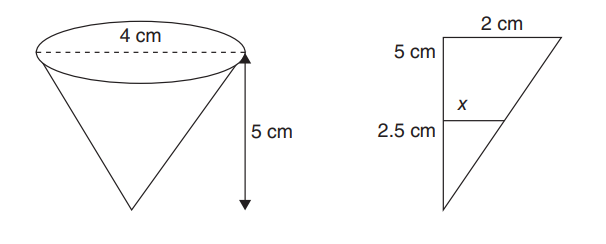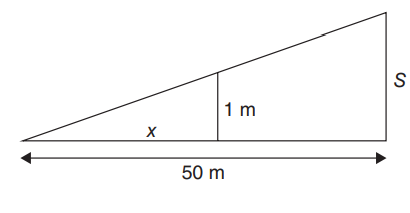Question
The area of a circular region is increasing at a rate of 96π square meters per second. When the area of the region is 64π square meters, how fast, in meters per second, is the radius of the region increasing?
(A) 6 (B) 8 (C) 16 (D)\(\sqrt[4]{3}\) (E)\(\sqrt[12]{3}\)
Answer/Explanation
Ans:A
Question
A spherical balloon is being inflated. What is the volume of the sphere at the instant when the rate of increase of the surface area is four times the rate of increase of the radius of the sphere?
(A) \(\frac{1}{2\pi }\) cubic units
(B) \(\frac{3\pi r^{2}}{2 }\) cubic units
(C) \(4\pi ^{2}\) cubic units
(D) \(\frac{1}{6\pi ^{2}}\) cubic units
Answer/Explanation
Ans: (D)
Let V be the volume of the sphere, s be the surface area of the sphere, and r be the radius of the sphere. You are given that dS/dt = 4 dr/dt.
\(S=4\pi r^{2}\)
\(\frac{\mathrm{d} S}{\mathrm{d} t}=8\pi r\frac{\mathrm{d} r}{\mathrm{d} t}\)
\(\frac{\mathrm{d} S}{\mathrm{d} t}=4\frac{\mathrm{d} r}{\mathrm{d} t}(given)\)
\(8\pi r\frac{\mathrm{d} S}{\mathrm{d} t}=4\frac{\mathrm{d} r}{\mathrm{d} t}\)
\(2\pi r=1\)
\(r=\frac{1}{2\pi }\)
\(V=\frac{4}{3}\pi r^{3}\)
\(V=\frac{4}{3}\pi \left ( \frac{1}{2\pi } \right )^{3}\)
\(V=\frac{4}{3}\pi \left ( \frac{1}{8\pi ^{3}} \right )\)
Question
A conical funnel has a base diameter of 4 cm and a height of 5 cm. The funnel is initially full, but water is draining at a constant rate of \(2cm^{3}/s\). How fast is the water level falling when the water is 2.5 cm high?
(A) \(\frac{1}{2\pi}\) cm/s
(B) \(-\frac{1}{2\pi}cm/s\)
(C) \(\frac{2}{\pi }cm/s\)
(D)\(-\frac{2}{\pi } cm/s\)
Answer/Explanation
Ans:(D)

\(\frac{2}{5}=\frac{r}{r}\)(Similar triangles)
2h=5r
\(r=\frac{2h}{5}\)
\(V=\frac{1}{3}\pi r^{2}h\)
\(V=\frac{1}{3}\pi \left ( \frac{2h}{5} \right )^{2}h\)
\(V=\frac{1}{3}\pi \left ( \frac{4h^{2}}{25} \right )h\)
\(V=\frac{4}{75}\pi h^{3}\)
\(\frac{\mathrm{d} V}{\mathrm{d} t}=3\left ( \frac{4}{75} \right )\pi h^{2}\frac{\mathrm{d} h}{\mathrm{d} t}\)
\(\frac{\mathrm{d} V}{\mathrm{d} t}=\left ( \frac{4}{25} \right )\pi h^{2}\frac{\mathrm{d} h}{\mathrm{d} t}\)
\(\frac{\mathrm{d} V}{\mathrm{d} t}=-2cm^{3}/s\)
\(-2=\left ( \frac{4}{25} \right )\pi h^{2}\frac{\mathrm{d} h}{\mathrm{d} t}\)
\(-1=\left ( \frac{2}{25} \right )\pi h^{2}\frac{\mathrm{d} h}{\mathrm{d} t}\)
\(\frac{\mathrm{d} h}{\mathrm{d} t}=-\frac{25}{2\pi h^{2}}\)
\(\frac{\mathrm{d} h}{\mathrm{d} t}=-\frac{25}{2\pi (2.5)^{2}}\)
Question
A light on the ground 50 m from a tall building shines on a 1-m tall child. The child is walking away from the light at a velocity of 1 m/s. How fast is the shadow on the building decreasing when the child is 10 m away from the building?
(A) \(-\frac{5}{4}m/s\)
(B) \(-\frac{1}{50}m/s\)
(C) \(-\frac{1}{32}m/s\)
(D)\(-\frac{1}{20}m/s\)
Answer/Explanation
Ans:(C)
Let S be the height of the shadow, x be the distance between the child and the light, and t be the time in seconds. You are given that the rate at which the child is moving
(dx/dt) is 1 m/s. You are asked to determine the rate of change of the shadow (dS/dt) when the child is 10 m from the building (x = 40 m).

\(\frac{1}{S}=\frac{x}{50}\)
\(S=\frac{50}{x}=50x^{-1}\)
\(\frac{\mathrm{d} S}{\mathrm{d} t}=-50x^{-2}\frac{\mathrm{d} x}{\mathrm{d} t}\)
\(\frac{\mathrm{d} x}{\mathrm{d} t}=1m/s \) (Given)
\(\frac{\mathrm{d} S}{\mathrm{d} t}=-\frac{50}{x^{2}}\)
\(\frac{\mathrm{d} S}{\mathrm{d} t}=-\frac{50}{(40)^{2}}\)
\(\frac{\mathrm{d} S}{\mathrm{d} t}=-\frac{50}{1600}\)
